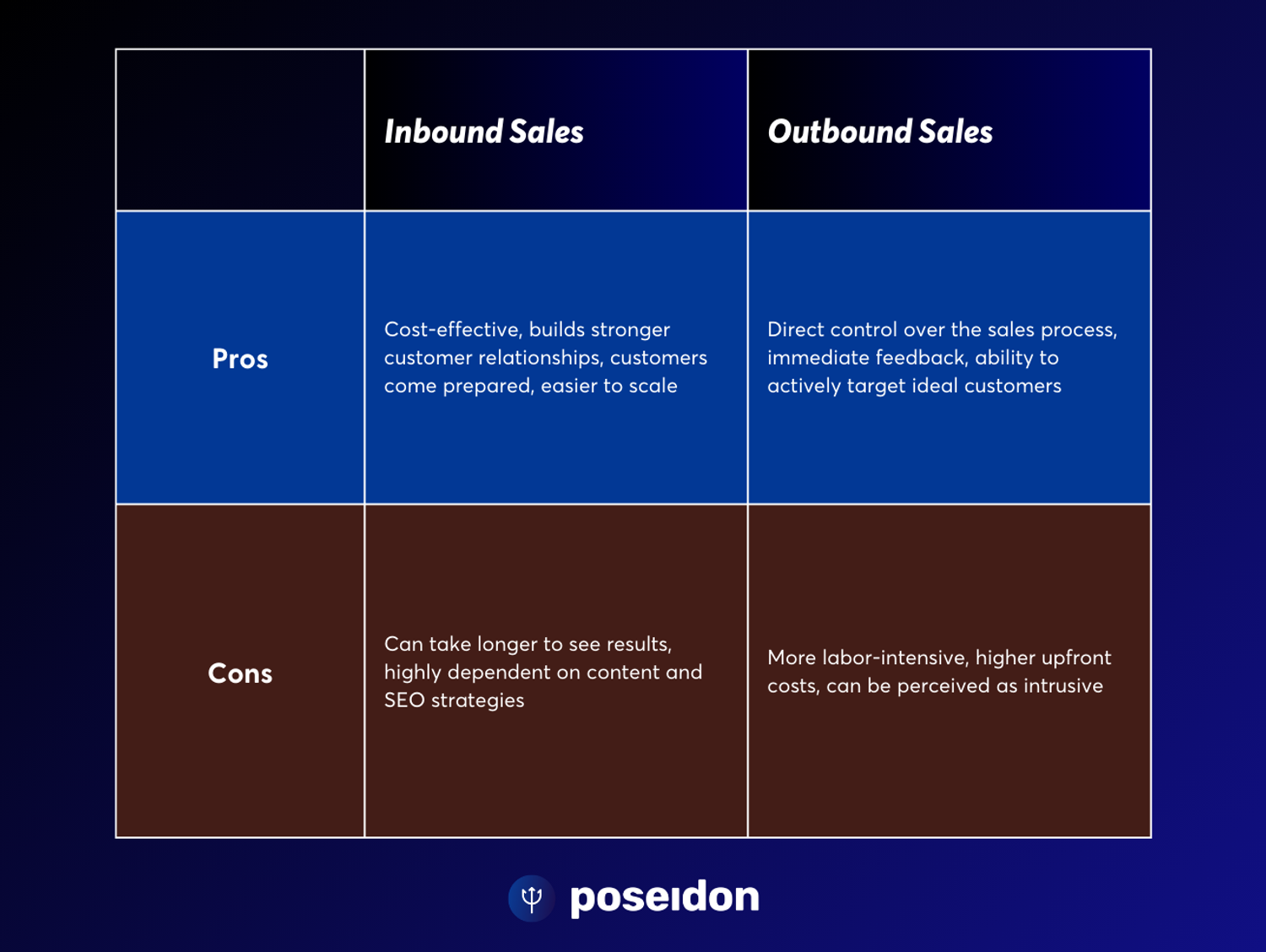Struggling to figure out how your sales team can more effectively seal deals?
Here's a fact: inbound and outbound sales tactics employ different strategies to win customers. This article lays down the critical differences, strategies, and best practices that can transform your approach.
Difference between Inbound and Outbound Sales Process
Inbound and outbound sales differ in their approaches to customer acquisition. Inbound sales involve drawing potential customers by creating valuable content, while outbound sales focus on proactive outreach through cold calling or emailing.
Inbound Sales
Inbound sales focus on attracting customers through content marketing, SEO strategies, and valuable content creation, all part of effective inbound strategies. This approach waits for potential clients to reach out first after they've interacted with the company's resources.
It centers around building relationships and providing solutions that meet customer’s needs.
Outbound Sales
Outbound sales involve proactive outreach to potential customers using methods such as cold calling, email campaigns, and social media messaging. Sales representatives use lead generation techniques to find prospects who haven't yet expressed interest in their products or services.
This strategy aims for immediate engagement by initiating conversations.
In inbound sales, content is king; in outbound sales, persistence pays off.
Pros and Cons
Understanding the differences between inbound and outbound sales is crucial for developing effective strategies. Each approach has its merits and drawbacks. Here's a closer examination:

4 Key Strategies for Effective Inbound Sales
To attract and engage ideal customers, businesses create valuable content and use it to qualify potential leads. They then pitch tailored solutions and negotiate to close deals effectively.
Identify and Attract Ideal Customers
Identifying and attracting ideal customers is the cornerstone of effective inbound sales. This involves creating valuable content specifically addressing the problems, needs, and interests of your target audience.
By utilizing strategies like content marketing and SEO techniques, businesses can draw potential customers into their sales funnel. Offering solutions that align with what these prospects are searching for makes your product or service stand out as an ideal choice.
Once you've captured their interest, further engagement through personalized emails or social media interactions helps solidify the relationship. Establishing a customer relationship based on value and trust encourages initial sales and also promotes customer retention.
This approach ensures that efforts are concentrated on individuals more likely to convert, optimizing both time and resources in the sales process.
Qualify and Pitch
In the realm of inbound sales, qualifying and pitching are crucial steps in converting leads into customers.
Here are key strategies for effectively qualifying and pitching in inbound sales:
- Research on the prospect's pain points, needs, and goals
- Personalized pitch on the prospect's specific challenges
- Communicate the unique value proposition clearly and succinctly
These strategies give you a strong foundation for engaging and converting potential customers.
Negotiating and Closing Deals
Negotiating and closing deals are the pivotal stages for sealing successful sales within the sales cycle.
These steps require finesse and strategic execution to ensure promising outcomes for the business.
- Understand the customer's needs
- Showcase the value of your product
- Overcome objections
- Propose a tailored solution
- Close the deal confidently
After successfully navigating negotiations and finalizing deals, businesses can move on to merging inbound and outbound sales strategies for comprehensive customer acquisition, involving both marketing team efforts and sales reps.
Why you should Inbound Sales strategy
Inbound sales is the right approach when your goal is to attract and engage with potential customers who are actively seeking solutions. The approach focuses on creating valuable content that educates and solves problems for your target audience, drawing them into your sales funnel through lead generation efforts such as email marketing, social media engagement, and SEO-driven content.
Inbound sales strategies emphasize building relationships with leads over time by delivering personalized and relevant information based on their needs and interests.
4 Key Strategies for Effective Outbound Sales
To achieve effective outbound sales, identifying and prospecting potential leads is crucial. By qualifying and pitching to these leads, you are positioning your product or service in a compelling way that speaks directly to their needs.
For more insight into mastering the art of outbound sales strategies, read on.
Prospecting and Building Lists
To achieve successful outbound sales, prospecting and building lists are crucial. Here are key strategies for effective prospecting and list-building:
- Use data-driven lead generation techniques
- Leverage Ai sales tool like Poseidon
- Use personalized outreach methods
- Regularly update and maintain database
Also read:
Moving forward, let's delve into the next crucial aspect of outbound sales - Outreach and Qualifying Leads.
Outreach and Qualifying Leads
Effective outreach and lead qualification are crucial for successful outbound sales. Utilize these strategies to maximize your results:
- Identify Ideal Prospects
- Personalize Outreach
- Utilize Multi-Channel Approach
- Qualify Leads Effectively
- Leverage Technology
These strategies will enhance your outreach efforts and ensure that you are effectively qualifying potential leads for your outbound sales initiatives.
Pitching and Overcoming Objections
Pitching and overcoming objections are crucial steps in the outbound sales process.
To effectively pitch, it's important to tailor your message to align with the prospect’s pain points. Overcoming objections requires active listening and addressing concerns head-on.
Leading prospects through a compelling pitch while effectively addressing objections sets the stage for closing successful deals in outbound sales.
Closing Deals
In the outbound sales process, closing deals is the pivotal moment that validates all the effort put into prospecting and pitching. It's the culmination of a successful outreach campaign and signifies a new customer relationship. Here are key steps to effectively close deals in outbound sales:
- Utilize persuasive language
- Overcome objections
- Create urgency
- Negotiate terms
- Follow up diligently
Closing deals in outbound sales demands strategic execution at each stage of interaction, ultimately culminating in successful conversions and customer acquisitions.
Signs that Outbound Sales is the Right Approach
The signs that outbound sales is the right approach include a proactive and assertive strategy to reach potential customers who may not have found your business otherwise. It involves actively seeking out prospects through cold outreach and lead generation, allowing for a broader reach beyond those already familiar with your brand.
Outbound sales can be effective when looking to scale quickly, tapping into new markets, or when targeting specific industries where direct contact with decision-makers is crucial for customer acquisition.
Outbound sales also proves beneficial in capturing the attention of high-value leads, showcasing how personalized outreach and relationship building can result in substantial returns.
This interactive process tailors one's value proposition and content marketing directly towards the needs of targeted customer segments, ultimately leading to increased customer retention and SaaS growth.
Combining Inbound and Outbound Sales: The Best of Both Worlds
By combining inbound and outbound sales strategies, businesses can expand their reach and attract potential customers while also actively pursuing leads. This approach allows for a comprehensive customer acquisition strategy that leverages the benefits of both methods.
Integrating proactive outreach with valuable content marketing can enhance lead generation, optimize the sales funnel, and maximize customer retention. By merging these two tactics, companies can create a tailored approach towards customer relationship building, ultimately resulting in a more cost-effective and efficient sales process.
This combination not only broadens the scope of customer acquisition but also increases the overall effectiveness of sales techniques.
The synergy between inbound and outbound sales unlocks new opportunities for SaaS growth as it provides a holistic perspective on navigating the complexities of customer acquisition in an ever-evolving market.
It's advisable to embark on this dual approach to leverage its potential for enhancing not just lead generation but also closing techniques. As businesses dive into this integrated strategy, they are well-positioned to unlock the secrets of successful customer relationship management through meticulous attention to personalized outreach within an ever-changing marketplace.
Conclusion
Inbound and outbound sales each offer distinct benefits and strategies for customer acquisition. Understanding the differences between them is crucial for tailoring your approach to the specific needs of your business and optimizing your sales and marketing efforts.
By combining the most effective elements of both, you can create a comprehensive sales strategy that maximizes your reach and impact. Adapting to the ever-evolving realm of sales tactics will ensure that you stay ahead in today's competitive marketplace.Successfully navigating these complexities will underpin your efforts to unlock the secrets of acquiring and retaining customers in a cost-effective manner.
Frequently Asked Questions (FAQs)
1. What is the difference between inbound and outbound sales?
Inbound sales involve attracting customers through content marketing and strategies that draw potential leads to your company, while outbound sales require sales reps to reach out to potential customers through methods like cold calls and emails.
2. How do inbound and outbound sales strategies differ?
Inbound strategies focus on creating valuable content to attract leads, nurturing them through the sales funnel, while outbound strategies involve proactive outreach to potential customers, often through direct sales pitches.
3. What is the importance of a sales team in the sales process?
A sales team plays a crucial role in driving revenue for a company by engaging with prospects, understanding their needs, and guiding them through the buying process to ultimately close deals.
4. How can a sales rep optimize their sales pitch?
A successful sales pitch should be tailored to the specific needs of the prospect, highlight the benefits of the product or service, and address any objections the potential customer may have.
5. What are some effective inbound sales strategies?
Effective inbound sales strategies include creating valuable content, using inbound lead generation techniques, and nurturing leads through personalized communication to build trust and drive conversions.
6. How does the sales funnel play a role in the sales cycle?
The sales funnel represents the stages that a prospect goes through before making a purchase. Understanding and optimizing each stage of the funnel can help improve sales and marketing efforts.
7. What are the key differences between inbound and outbound sales processes?
Inbound sales processes focus on attracting and engaging leads through valuable content, while outbound sales processes involve reaching out to prospects directly with sales offers.
8. How can a sales professional utilize inbound and outbound strategies effectively?
A skilled sales professional can leverage both inbound and outbound strategies by understanding the target audience, using the right sales tools, and aligning sales efforts with




![Best LinkedIn Sales Strategy In 2025 [+Templates]](https://cdn.sanity.io/images/l79olr63/production/f506b7ad35e15d3d5fcdb46ee807bbda7f5df908-1232x928.webp)
